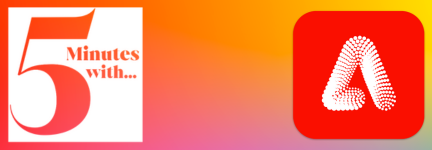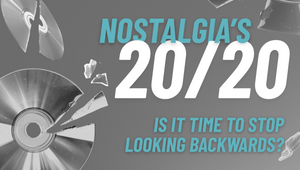
5 Minutes with… Lauren Castagni Mote

Lauren Castagni Mote’s career started at 19 when she dropped out of university and got a one way ticket to Los Angeles to crash writing camps with producers. At 22, Lauren started a record label without any major backing and got tracks on Spotify's charts, placement on global playlists, and syncs on Hollywood film soundtracks. At Universal Music, where she was a marketer, Lauren learnt all about the power of fandoms, and her expertise also spans launching brands for YouTube shows, investing in start ups, and even trying her hand at a pet social network.
With Sage7, which Lauren bills as a “fandom-first creative studio and consultancy turning bands and talent into cultural obsession,” she’s putting all that she’s learned into practice. By fusing strategy, creativity, and deep cultural insights, Sage7 is dedicated to helping brands build resonance, not just reach. “Too much work chases impressions instead of impact. It’s polished, but pointless,” Lauren says. She notes that too much advertising today confuses data with insight, resulting in work that’s not emotionally captivating and therefore easy to ignore.
LBB’s Zhenya Tsenzharyk caught up with Lauren to learn more about her career, how Sage7 helps brands find a place in culture, and why audiences want to feel like brand insiders and co-creators, not passive consumers.
LBB> Sage7’s expertise is in fandoms and 'brandoms'. Until recently, Sage7 has been more of a silent partner to brands and agencies – why is now the right time to take some of the spotlight for yourself? And how will you be doing that?
Lauren> Both culture and our industry move fast, so how you show up matters just as much as what you do. Over the past year, we’ve partnered with some incredible brands and agencies. The work we’ve delivered – and the results it’s driven – have helped us refine and prove our approach. We’ve been busy. And now we’ve got the receipts: the brands, the results, our own case studies. That’s given us the confidence to stop whispering and start shouting. We’re trying to be intentional as we step into the spotlight – sharing more thought leadership on building fandoms and cult brands, more of our point-of-view, more creativity and more cultural clarity.
The goal isn’t just fame – it’s conviction. Sage7 does fandom-first brand building that works. You’ll be hearing that a lot more and not just from us.
LBB> You were a marketer for Universal Music and musicians have maybe the most dedicated fans out there. What kind of lessons did you learn from that time in your career and how have you been applying them to your clients at Sage7?
Lauren> Working in music is a cheat code for understanding audiences and culture. Musicians aren’t just ‘brands’, they’re movements. They build tribes. They create emotional connections that often outweigh logic, price, or even product. Marketers can learn a lot from that behaviour. For example, there seems to be a misconception that ‘fandom’ is only relevant to younger audiences. When I worked on Take That's 'Odyssey', a greatest hits album – which at the time was a record-breaking pre-order – I had mums tweeting me from the school-run asking for pre-sale codes and product restocks.
That period taught me to appreciate the spectrum of culture. How much people will champion what they care about. How identity and commerce can work together. The importance of taste. That the experience is everything. And how the artist-to-fan relationship is a masterclass in long-term engagement. At Sage7, we apply that thinking every day.
We don’t chase virality or volume. We build relevance, meaning and memory.
Resonance over reach. Because that’s what drives real advocacy.
LBB> You also have a lot of personal experience in creating, building, and supporting things that people care about having worked on YouTube shows, RTD cocktails, coffee pods, and a pet social network, to name just a few. Can you share some insights that these experiences have given you?
Lauren> First, that brand-building should be audience led. I'm stating the obvious, but too much advertising and marketing today lacks emotional instinct. It confuses data with insight. Knowing when someone catches their train isn’t helpful unless you understand what gets them excited, how they want to feel and how they want to be seen. When I launched lifestyle brands for some of YouTube's biggest shows, their fans were crying out for merch. They wanted to rep the shows, but they also wanted to signal to other people that they watched them.
Second, ‘zeitgeist’ moments can be manufactured – if you land the emotional truth. But paradoxically, they can also be totally random. That’s why brands (and talent) need to stay brave. Try things. Then keep trying. I started a record label at 22 years old without any major backing and somehow ended up getting tracks on Spotify's charts, placement on global playlists and syncs on Hollywood film soundtracks. I had to think differently, which helped us stand out.
And lastly: most brands overestimate how much people care. Fandom has to be earned - with personality, purpose and a little provocation. The details matter. Cultural cues, vibe, tone, timing – they all add up to real brand equity.
LBB> How have those experiences shaped the way you approach Sage7’s work?
Lauren> They taught me to trust the edges. We don’t water things down. We don’t do ‘meh but safe’. We build sharp, smart, culturally literate brands people genuinely connect with. And that starts by obsessing over the people you’re speaking to.
We always ask:
Would someone fight for this brand?
Would they notice – or care – if it disappeared? If the answer’s no, we go back to the drawing board.
LBB> There’s been a lot of talk about how brands need to be 'fandom-first' today; what’s your view on this strategy?
Lauren> Fandom-first isn’t a trend. It’s a truth. In a world of too much everything, people only invest time and energy in things they genuinely care about. That’s fandom. And that’s the future. It’s not just about superfans or shouty loyalty. It’s about emotional investment.
When you earn that, your brand moves faster, lasts longer, and gets talked about for the right reasons.
LBB> Can every brand cultivate a fandom, or a ‘brandom’? Should they all be trying?
Lauren> Not every brand can build a cult following. But every brand can build connection. Fandom doesn’t always mean screaming crowds – sometimes it’s subtle. What matters is depth over scale. If 10,000 people really love your brand, that’s more powerful than 100,000 who barely remember it. Those 10,000 are the ones who will get you to 100,000. The brands that win long-term are the ones that focus on resonance, not just reach.
LBB> Sage7’s mission is to do away with ‘vapid work’ and media metrics that look to reach over resonance. Can you please expand on this some more?
Lauren> Too much work chases impressions instead of impact. It’s polished, but pointless. We believe brand building should mean something – to real people, in real culture. That’s why we obsess over story, tone, experience, subcultures and communities. We don’t just track metrics – we make sure we move people. Vibes over vanity. Meaning over media plans. That’s how brands stay relevant. And when you're relevant, the results will follow.
LBB> In your view, what recent behavioural or cultural changes have most significantly influenced consumer engagement strategies?
Lauren> Audiences don’t want to be talked at anymore. They want to co-create, remix and feel like they’re part of something from the inside. That’s fundamentally shifting how smart brands show up – with social-first formats like memes, video, shareable/UGC moments, and drops being conceptualised alongside the classic polished paid campaign. It’s not about shortcutting via influencers. It’s about speaking the language of your audience so they choose to claim you.
At the same time, mass marketing is losing its grip. Cultural capital lives in micro-communities and hyper-targeted audiences, so the best strategies have stopped trying to be everything to everyone. It’s no longer about reaching broad demographics – it’s about resonating deeply with someone and letting that energy spread. Audiences are over the generic formula. They can smell it. Over-thought, over-safe, made for industry peers instead of real people. What’s landing now is clarity, conviction and cultural fluency. Say something. Stand for something. Or risk being scrolled past.
LBB> Looking ahead, what emerging trends do you foresee shaping the future of brand strategy and consumer engagement? And which ones do you think are going to be too short-lived to dedicate attention to?
Lauren> Fan-led communities, creator-brand hybrids, audience-specific storytelling, cultural fluency and strategic restraint (not doing more, doing better) should all be part of the plan. Having a faux-edgy brand voice to mask your safe ideas, and trend-hopping with no POV should be binned. The future is about coherence, strong POVs, smart strategy and knowing your audience. And most importantly brand energy that earns attention.
LBB> Is there anything else you would like to share with LBB?
Lauren> Just this: creative effectiveness isn’t about ticking boxes or chasing awards. It’s about relevance. Real-world, cultural, fan-powered relevance. That’s what we do at Sage7. And we’re just getting started.












